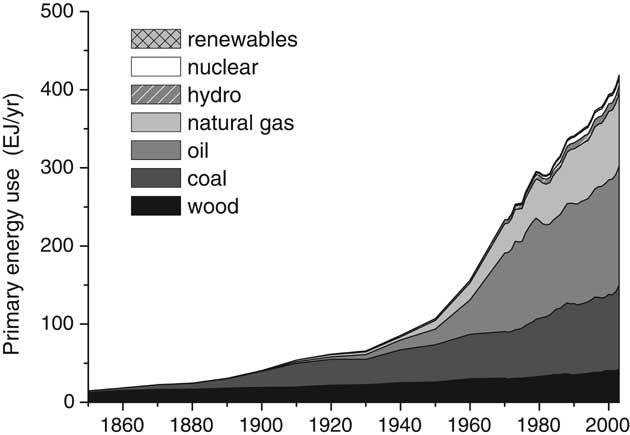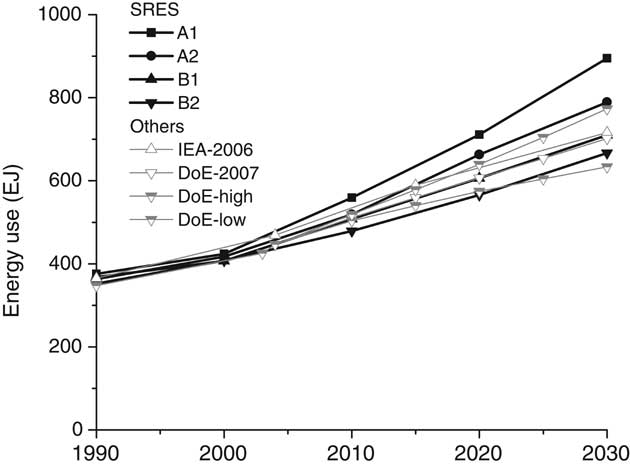
Figure 4-27. Global energy use from 1880-2000. Source: Van Vuuren, 2007.
ergy, or about 7% of total consumption (Ramirez-Ramirez, 2005). Within this total, nearly 45% is consumed by the food processing industries, around 25% by agriculture, around 10-15% by transport of foodstuffs and fodder and the remainder (5-10% each) for fertilizer manufacturing and transport of agricultural products.
The rapid population growth expected in developing countries is likely to have important implications for the relationship between energy use and agriculture. Increasing food production will require a strategy of intensification and consequently a further increase in the consumption of fossil energy for agricultural production. As this process is likely to coincide with structural changes in the economy, lower labor supply in agriculture will also lead to further intensification. As a result, systems in developing countries are expected to see considerable growth in energy consumption

Figure 4-28. Trends in 21st century energy use. Comparison of trends in SRES total primary energy consumption and more recent studies by US.DoE and IEA. Source: USDoE, 2004; IEA 2004, 2006.
for food processing. Overall, this is likely to lead to further growth in agriculture energy demand, although at a lower rate than overall growth of energy consumption.
One additional factor is the role of energy prices; current high prices for oil and natural gas do have consequences, primarily on fertilizer use and transport, for agriculture. Projections for energy prices in the next decades have been revised upward in most reports (e.g., IEA, 2006), but still a considerable uncertainty remains. Higher projections are found for those projections that take into account further increased demand in Asia and restrictions (e.g., limited investments, depletion) on increases in supply.
4.4.5.3 Bioenergy
Climate change, energy security and the search for alternative income sources for agriculture have increased interest in bioenergy as an alternative fossil fuel. Many scenario studies, with and without climate policy constraints, project a strong increase in the use of bioenergy, with major implications for future agriculture (see IPCC, 2007c). However, at the same time there is a strong debate on the implications of bioenergy use; the outcome of this debate will critically influence its future use (see also Slesser and Lewis, 1979; Smil, 2003; Smeets and Faaij, 2004; Hoogwijk et al., 2005). Crucial controversies with respect to bioenergy use include whether bioenergy can provide net energy gains, reduce greenhouse gas emissions, cost-benefit ratio, environmental implications and the effects on food crop production (Box 4-4).
The potential for bioenergy production typically is based on land use projections (e.g., Smeets and Faaij, 2004). From a technical perspective, bioenergy could supply several hundred exajoules per year from 2050 onwards compared to a current global energy use of 420 EJ of which some 10% is covered by bioenergy already, predominantly in the form of traditional bioenergy. The major reason for the divergence among different estimates of bioenergy potentials is that the two most crucial parameters, land availability and yield levels in energy crop production, are very uncertain. The development of cellulosic ethanol could lead to much higher yields per hectare (see Chapter 6). Another factor concerns the availability of forest wood and agriculture and forestry residues. In particular, the use of forest wood has been identified as a potentially major source of biomass for energy (up to about 115 EJ yr"1 in 2050) but very low estimates are also reported.
In evaluating the information on bioenergy potential, the costs, land requirements and the environmental constraints will determine whether biomass can be transformed into a viable net energy supply to society. Hence, the drivers are (1) population growth and economic development; (2) intensity of food production systems, (3) feasibility of the use of marginal/degraded lands, (4) productivity forests and sustainable harvest levels, (5) the (increased) utilization of biomaterials, (6) limitations in land and water availability. Scenario studies evaluate bioenergy mostly in terms of competition against energy carriers and thus give an indication of demand. Bioenergy use in various energy scenarios varies widely (Figure 4-29). In these scenarios, use of bioenergy varies between 0 and 125 EJ yr-1 in 2030 and 25 and 250 EJ in 2050.